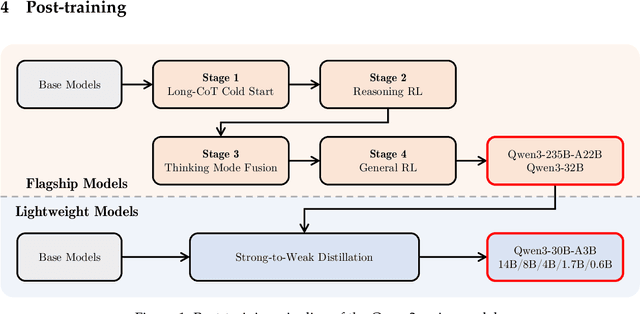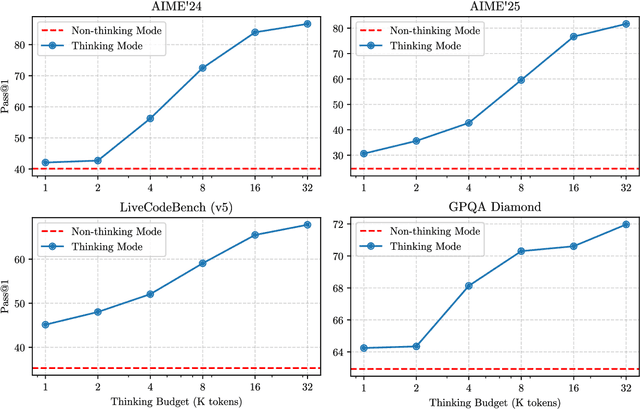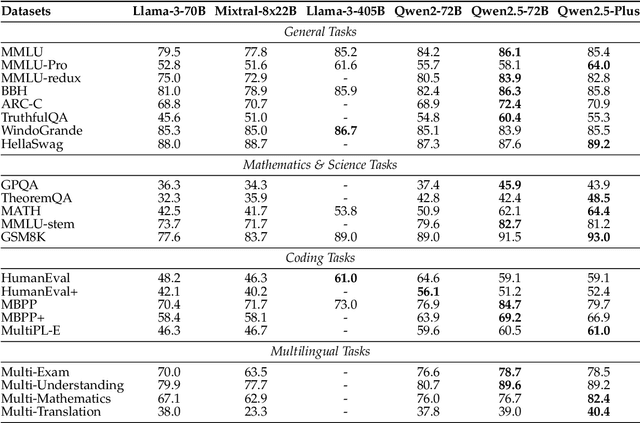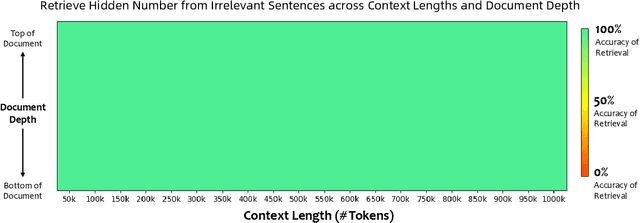Tianhao Li
additional authors not shown
MMOT: The First Challenging Benchmark for Drone-based Multispectral Multi-Object Tracking
Oct 14, 2025Abstract:Drone-based multi-object tracking is essential yet highly challenging due to small targets, severe occlusions, and cluttered backgrounds. Existing RGB-based tracking algorithms heavily depend on spatial appearance cues such as color and texture, which often degrade in aerial views, compromising reliability. Multispectral imagery, capturing pixel-level spectral reflectance, provides crucial cues that enhance object discriminability under degraded spatial conditions. However, the lack of dedicated multispectral UAV datasets has hindered progress in this domain. To bridge this gap, we introduce MMOT, the first challenging benchmark for drone-based multispectral multi-object tracking. It features three key characteristics: (i) Large Scale - 125 video sequences with over 488.8K annotations across eight categories; (ii) Comprehensive Challenges - covering diverse conditions such as extreme small targets, high-density scenarios, severe occlusions, and complex motion; and (iii) Precise Oriented Annotations - enabling accurate localization and reduced ambiguity under aerial perspectives. To better extract spectral features and leverage oriented annotations, we further present a multispectral and orientation-aware MOT scheme adapting existing methods, featuring: (i) a lightweight Spectral 3D-Stem integrating spectral features while preserving compatibility with RGB pretraining; (ii) an orientation-aware Kalman filter for precise state estimation; and (iii) an end-to-end orientation-adaptive transformer. Extensive experiments across representative trackers consistently show that multispectral input markedly improves tracking performance over RGB baselines, particularly for small and densely packed objects. We believe our work will advance drone-based multispectral multi-object tracking research. Our MMOT, code, and benchmarks are publicly available at https://github.com/Annzstbl/MMOT.
A Survey of Vibe Coding with Large Language Models
Oct 14, 2025Abstract:The advancement of large language models (LLMs) has catalyzed a paradigm shift from code generation assistance to autonomous coding agents, enabling a novel development methodology termed "Vibe Coding" where developers validate AI-generated implementations through outcome observation rather than line-by-line code comprehension. Despite its transformative potential, the effectiveness of this emergent paradigm remains under-explored, with empirical evidence revealing unexpected productivity losses and fundamental challenges in human-AI collaboration. To address this gap, this survey provides the first comprehensive and systematic review of Vibe Coding with large language models, establishing both theoretical foundations and practical frameworks for this transformative development approach. Drawing from systematic analysis of over 1000 research papers, we survey the entire vibe coding ecosystem, examining critical infrastructure components including LLMs for coding, LLM-based coding agent, development environment of coding agent, and feedback mechanisms. We first introduce Vibe Coding as a formal discipline by formalizing it through a Constrained Markov Decision Process that captures the dynamic triadic relationship among human developers, software projects, and coding agents. Building upon this theoretical foundation, we then synthesize existing practices into five distinct development models: Unconstrained Automation, Iterative Conversational Collaboration, Planning-Driven, Test-Driven, and Context-Enhanced Models, thus providing the first comprehensive taxonomy in this domain. Critically, our analysis reveals that successful Vibe Coding depends not merely on agent capabilities but on systematic context engineering, well-established development environments, and human-agent collaborative development models.
GTAD: Global Temporal Aggregation Denoising Learning for 3D Semantic Occupancy Prediction
Jul 28, 2025Abstract:Accurately perceiving dynamic environments is a fundamental task for autonomous driving and robotic systems. Existing methods inadequately utilize temporal information, relying mainly on local temporal interactions between adjacent frames and failing to leverage global sequence information effectively. To address this limitation, we investigate how to effectively aggregate global temporal features from temporal sequences, aiming to achieve occupancy representations that efficiently utilize global temporal information from historical observations. For this purpose, we propose a global temporal aggregation denoising network named GTAD, introducing a global temporal information aggregation framework as a new paradigm for holistic 3D scene understanding. Our method employs an in-model latent denoising network to aggregate local temporal features from the current moment and global temporal features from historical sequences. This approach enables the effective perception of both fine-grained temporal information from adjacent frames and global temporal patterns from historical observations. As a result, it provides a more coherent and comprehensive understanding of the environment. Extensive experiments on the nuScenes and Occ3D-nuScenes benchmark and ablation studies demonstrate the superiority of our method.
Qwen3 Technical Report
May 14, 2025



Abstract:In this work, we present Qwen3, the latest version of the Qwen model family. Qwen3 comprises a series of large language models (LLMs) designed to advance performance, efficiency, and multilingual capabilities. The Qwen3 series includes models of both dense and Mixture-of-Expert (MoE) architectures, with parameter scales ranging from 0.6 to 235 billion. A key innovation in Qwen3 is the integration of thinking mode (for complex, multi-step reasoning) and non-thinking mode (for rapid, context-driven responses) into a unified framework. This eliminates the need to switch between different models--such as chat-optimized models (e.g., GPT-4o) and dedicated reasoning models (e.g., QwQ-32B)--and enables dynamic mode switching based on user queries or chat templates. Meanwhile, Qwen3 introduces a thinking budget mechanism, allowing users to allocate computational resources adaptively during inference, thereby balancing latency and performance based on task complexity. Moreover, by leveraging the knowledge from the flagship models, we significantly reduce the computational resources required to build smaller-scale models, while ensuring their highly competitive performance. Empirical evaluations demonstrate that Qwen3 achieves state-of-the-art results across diverse benchmarks, including tasks in code generation, mathematical reasoning, agent tasks, etc., competitive against larger MoE models and proprietary models. Compared to its predecessor Qwen2.5, Qwen3 expands multilingual support from 29 to 119 languages and dialects, enhancing global accessibility through improved cross-lingual understanding and generation capabilities. To facilitate reproducibility and community-driven research and development, all Qwen3 models are publicly accessible under Apache 2.0.
Enhancing LLM Language Adaption through Cross-lingual In-Context Pre-training
Apr 29, 2025Abstract:Large language models (LLMs) exhibit remarkable multilingual capabilities despite English-dominated pre-training, attributed to cross-lingual mechanisms during pre-training. Existing methods for enhancing cross-lingual transfer remain constrained by parallel resources, suffering from limited linguistic and domain coverage. We propose Cross-lingual In-context Pre-training (CrossIC-PT), a simple and scalable approach that enhances cross-lingual transfer by leveraging semantically related bilingual texts via simple next-word prediction. We construct CrossIC-PT samples by interleaving semantic-related bilingual Wikipedia documents into a single context window. To access window size constraints, we implement a systematic segmentation policy to split long bilingual document pairs into chunks while adjusting the sliding window mechanism to preserve contextual coherence. We further extend data availability through a semantic retrieval framework to construct CrossIC-PT samples from web-crawled corpus. Experimental results demonstrate that CrossIC-PT improves multilingual performance on three models (Llama-3.1-8B, Qwen2.5-7B, and Qwen2.5-1.5B) across six target languages, yielding performance gains of 3.79%, 3.99%, and 1.95%, respectively, with additional improvements after data augmentation.
GuideLLM: Exploring LLM-Guided Conversation with Applications in Autobiography Interviewing
Feb 10, 2025



Abstract:Although Large Language Models (LLMs) succeed in human-guided conversations such as instruction following and question answering, the potential of LLM-guided conversations-where LLMs direct the discourse and steer the conversation's objectives-remains under-explored. In this study, we first characterize LLM-guided conversation into three fundamental components: (i) Goal Navigation; (ii) Context Management; (iii) Empathetic Engagement, and propose GuideLLM as an installation. We then implement an interviewing environment for the evaluation of LLM-guided conversation. Specifically, various topics are involved in this environment for comprehensive interviewing evaluation, resulting in around 1.4k turns of utterances, 184k tokens, and over 200 events mentioned during the interviewing for each chatbot evaluation. We compare GuideLLM with 6 state-of-the-art LLMs such as GPT-4o and Llama-3-70b-Instruct, from the perspective of interviewing quality, and autobiography generation quality. For automatic evaluation, we derive user proxies from multiple autobiographies and employ LLM-as-a-judge to score LLM behaviors. We further conduct a human-involved experiment by employing 45 human participants to chat with GuideLLM and baselines. We then collect human feedback, preferences, and ratings regarding the qualities of conversation and autobiography. Experimental results indicate that GuideLLM significantly outperforms baseline LLMs in automatic evaluation and achieves consistent leading performances in human ratings.
Synthetic Poisoning Attacks: The Impact of Poisoned MRI Image on U-Net Brain Tumor Segmentation
Feb 06, 2025Abstract:Deep learning-based medical image segmentation models, such as U-Net, rely on high-quality annotated datasets to achieve accurate predictions. However, the increasing use of generative models for synthetic data augmentation introduces potential risks, particularly in the absence of rigorous quality control. In this paper, we investigate the impact of synthetic MRI data on the robustness and segmentation accuracy of U-Net models for brain tumor segmentation. Specifically, we generate synthetic T1-contrast-enhanced (T1-Ce) MRI scans using a GAN-based model with a shared encoding-decoding framework and shortest-path regularization. To quantify the effect of synthetic data contamination, we train U-Net models on progressively "poisoned" datasets, where synthetic data proportions range from 16.67% to 83.33%. Experimental results on a real MRI validation set reveal a significant performance degradation as synthetic data increases, with Dice coefficients dropping from 0.8937 (33.33% synthetic) to 0.7474 (83.33% synthetic). Accuracy and sensitivity exhibit similar downward trends, demonstrating the detrimental effect of synthetic data on segmentation robustness. These findings underscore the importance of quality control in synthetic data integration and highlight the risks of unregulated synthetic augmentation in medical image analysis. Our study provides critical insights for the development of more reliable and trustworthy AI-driven medical imaging systems.
Qwen2.5 Technical Report
Dec 19, 2024



Abstract:In this report, we introduce Qwen2.5, a comprehensive series of large language models (LLMs) designed to meet diverse needs. Compared to previous iterations, Qwen 2.5 has been significantly improved during both the pre-training and post-training stages. In terms of pre-training, we have scaled the high-quality pre-training datasets from the previous 7 trillion tokens to 18 trillion tokens. This provides a strong foundation for common sense, expert knowledge, and reasoning capabilities. In terms of post-training, we implement intricate supervised finetuning with over 1 million samples, as well as multistage reinforcement learning. Post-training techniques enhance human preference, and notably improve long text generation, structural data analysis, and instruction following. To handle diverse and varied use cases effectively, we present Qwen2.5 LLM series in rich sizes. Open-weight offerings include base and instruction-tuned models, with quantized versions available. In addition, for hosted solutions, the proprietary models currently include two mixture-of-experts (MoE) variants: Qwen2.5-Turbo and Qwen2.5-Plus, both available from Alibaba Cloud Model Studio. Qwen2.5 has demonstrated top-tier performance on a wide range of benchmarks evaluating language understanding, reasoning, mathematics, coding, human preference alignment, etc. Specifically, the open-weight flagship Qwen2.5-72B-Instruct outperforms a number of open and proprietary models and demonstrates competitive performance to the state-of-the-art open-weight model, Llama-3-405B-Instruct, which is around 5 times larger. Qwen2.5-Turbo and Qwen2.5-Plus offer superior cost-effectiveness while performing competitively against GPT-4o-mini and GPT-4o respectively. Additionally, as the foundation, Qwen2.5 models have been instrumental in training specialized models such as Qwen2.5-Math, Qwen2.5-Coder, QwQ, and multimodal models.
Path-RAG: Knowledge-Guided Key Region Retrieval for Open-ended Pathology Visual Question Answering
Nov 26, 2024



Abstract:Accurate diagnosis and prognosis assisted by pathology images are essential for cancer treatment selection and planning. Despite the recent trend of adopting deep-learning approaches for analyzing complex pathology images, they fall short as they often overlook the domain-expert understanding of tissue structure and cell composition. In this work, we focus on a challenging Open-ended Pathology VQA (PathVQA-Open) task and propose a novel framework named Path-RAG, which leverages HistoCartography to retrieve relevant domain knowledge from pathology images and significantly improves performance on PathVQA-Open. Admitting the complexity of pathology image analysis, Path-RAG adopts a human-centered AI approach by retrieving domain knowledge using HistoCartography to select the relevant patches from pathology images. Our experiments suggest that domain guidance can significantly boost the accuracy of LLaVA-Med from 38% to 47%, with a notable gain of 28% for H&E-stained pathology images in the PathVQA-Open dataset. For longer-form question and answer pairs, our model consistently achieves significant improvements of 32.5% in ARCH-Open PubMed and 30.6% in ARCH-Open Books on H\&E images. Our code and dataset is available here (https://github.com/embedded-robotics/path-rag).
SciSafeEval: A Comprehensive Benchmark for Safety Alignment of Large Language Models in Scientific Tasks
Oct 02, 2024



Abstract:Large language models (LLMs) have had a transformative impact on a variety of scientific tasks across disciplines such as biology, chemistry, medicine, and physics. However, ensuring the safety alignment of these models in scientific research remains an underexplored area, with existing benchmarks primarily focus on textual content and overlooking key scientific representations such as molecular, protein, and genomic languages. Moreover, the safety mechanisms of LLMs in scientific tasks are insufficiently studied. To address these limitations, we introduce SciSafeEval, a comprehensive benchmark designed to evaluate the safety alignment of LLMs across a range of scientific tasks. SciSafeEval spans multiple scientific languages - including textual, molecular, protein, and genomic - and covers a wide range of scientific domains. We evaluate LLMs in zero-shot, few-shot and chain-of-thought settings, and introduce a 'jailbreak' enhancement feature that challenges LLMs equipped with safety guardrails, rigorously testing their defenses against malicious intention. Our benchmark surpasses existing safety datasets in both scale and scope, providing a robust platform for assessing the safety and performance of LLMs in scientific contexts. This work aims to facilitate the responsible development and deployment of LLMs, promoting alignment with safety and ethical standards in scientific research.
 Add to Chrome
Add to Chrome Add to Firefox
Add to Firefox Add to Edge
Add to Edge